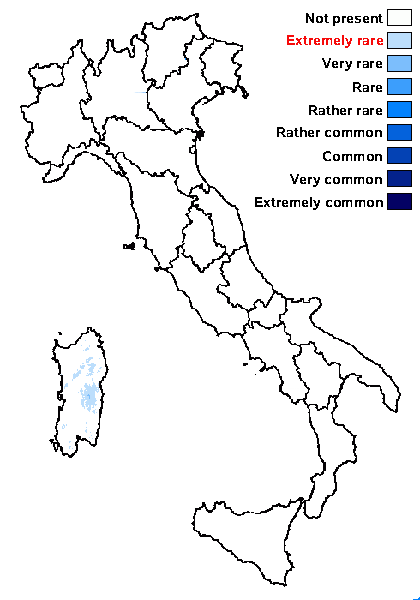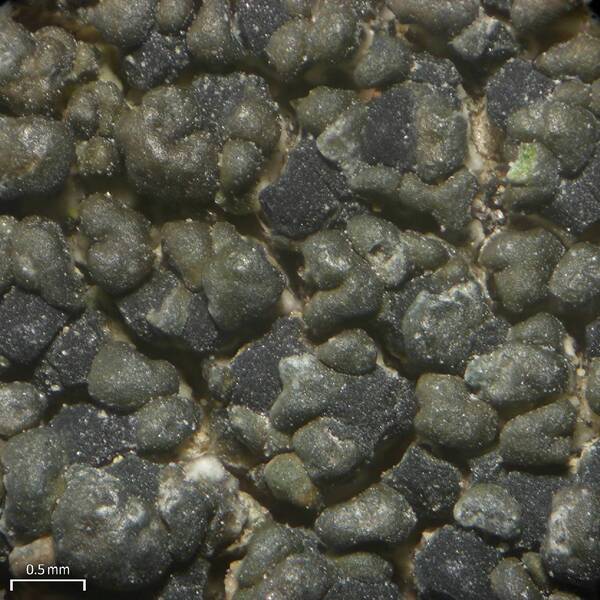Carbonea assimilis (Körb.) Hafellner & Hertel
in Wirth, Flechten Baden-Württembergs: 511, 1987. Basionym: Lecidella assimilis Hampe ex Körb. - Parerga Lichenol.: 202, 1861.
Synonyms: Lecidea assimilis (Körb.) Th. Fr.
Distribution: C - Sar.
Description: Thallus crustose, areolate-verrucose, pale to dark brown, usually slightly glossy, sometimes starting the life-cycle on other crustose lichens, the areoles contiguous, 0.3-1.6 mm wide, 0.1-0.8 mm thick, strongly convex to almost bullate. Medulla white, I-. Apothecia lecideine, epruinose, glossy black, scattered or clustered in small groups, mostly marginal on the areoles, sessile and constricted at base, round to angular by mutual pressure, (0.2-)0.3-0.6(-0.8) mm across, with a concave to slightly convex disc and a thin, flexuous, prominent proper margin. Proper exciple dark brown or black in central part, green-black or olive in marginal part; epithecium bright blue-green, N+ purple-red; hymenium colourless to greenish in upper part, 45-65 µm high; paraphyses coherent, simple, frequently anastomosing, 1-2 µm thick at mid-level, the apical cells swollen, up to 2.5 µm wide; hypothecium colourless, 50-150 µm high. Asci 8-spored, very thin-walled, with a tall apical dome, Lecanora-type. Ascospores 1-celled, hyaline, ellipsoid to ovoid, (8-)10-15 x 5-8(-9.5) µm, usually >1.5 times as long as wide. Photobiont chlorococcoid. Spot tests: Thallus K-, C-, KC-, P-, UV-. Chemistry: without lichen substances.Note: a species with a thallus of minute pale brown glossy areoles which are diagnostic, found on exposed inclined rock faces of siliceous rocks. Purported to start the life-cycle on other crustose lichens (e.g. species of Aspicilia, Lecanora, Lecidea), but according to Hafellner (2021) probably non-lichenicolous. Perhaps more widespread but not common, perhaps overlooked in Italy.
Growth form: Crustose
Substrata: rocks
Photobiont: green algae other than Trentepohlia
Reproductive strategy: mainly sexual
Most common in areas with a humid-warm climate (e.g. most of Tyrrenian Italy)
paras crustose lichens
Commonnes-rarity: (info)
Alpine belt: very rare
Subalpine belt: very rare
Oromediterranean belt: very rare
Montane belt: extremely rare
Submediterranean belt: absent
Padanian area: absent
Humid submediterranean belt: absent
Humid mediterranean belt: absent
Dry mediterranean belt: absent

Predictive model
Growth form: Crustose
Substrata: rocks
Photobiont: green algae other than Trentepohlia
Reproductive strategy: mainly sexual
Most common in areas with a humid-warm climate (e.g. most of Tyrrenian Italy)
paras crustose lichens
Commonnes-rarity: (info)
Alpine belt: very rare
Subalpine belt: very rare
Oromediterranean belt: very rare
Montane belt: extremely rare
Submediterranean belt: absent
Padanian area: absent
Humid submediterranean belt: absent
Humid mediterranean belt: absent
Dry mediterranean belt: absent

Predictive model
 INDEX FUNGORUM
INDEX FUNGORUM
 GBIF
GBIF


